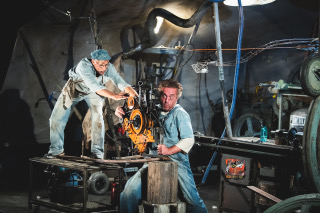Festival mondial des theatres de marionettes

Every second year for ten days in September the small Renaissance city of Charleville-Mezieres in northeastern France hosts Festival mondial des theatres de marionettes - The World Festival of Puppetry . You don’t know what it means to be festive until you’ve come to this event! The town is filled with people of all ages - many senior folks, and always sober - enjoying the cornucopia of puppetry events spread out before them. It’s terrific, with shows, internships for children, workshops for puppeteers, street performers - everything a festival needs! The 2019 event was the 20th biannual, and I was lucky enough to be there with my critic’s notebook. The opening event was Place des anges , a pageant presented in the beautiful old town square. Brightly lit acrobats - white angels - dropped white feathers on the crowd. Angelic indeed! It was marred only by the hyper-amplified base of techno-music or whatever it was. Aside from the scheduled performances, the streets of ...







